Antiques, Replicas and All Their Cousins
Old style jewelry is the latest fashion. Estate jewelry…
vintage…. antique… period… retro… deco –
these are some of the terms that set the mood.
How important are such terms when it comes to valuation?
What the Terms Mean
Because old-style jewelry is so fashionable, romantic buzzwords abound. Some of the terms are descriptive, others just create emotional appeal.
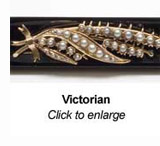 Antique is the most definable. Jewelry that is at least 100
years old may be called antique. In some realms this specificity of date is
important. For example, jewelry more than 100 years old can be brought into
the United States (and various other countries) duty-free.
Antique is the most definable. Jewelry that is at least 100
years old may be called antique. In some realms this specificity of date is
important. For example, jewelry more than 100 years old can be brought into
the United States (and various other countries) duty-free.
Estate jewelry really just means property left in someone’s will. Some jewelers specialize in estate jewelry, recognizing and buying only fine-quality pieces. Certainly not all estate jewelry is valuable (or even old), but occasionally jewelry’s provenance does dramatically heighten its value, as when pieces from the estate of the Duchess of Windsor fetched high prices at Sotheby’s.
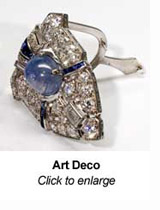 In the marketplace, however, the term “estate” jewelry is often
used merely as a romantic substitute for “previously owned.”
It is meant to imply quality. The phrase suggests that the jewelry is old
(which isn’t necessarily true), and then plays on the popular notion
that old jewelry is valuable by definition. Some jewelers have even been known
to take stock that isn’t selling and move it into the “estate
jewelry” case to increase sales.
In the marketplace, however, the term “estate” jewelry is often
used merely as a romantic substitute for “previously owned.”
It is meant to imply quality. The phrase suggests that the jewelry is old
(which isn’t necessarily true), and then plays on the popular notion
that old jewelry is valuable by definition. Some jewelers have even been known
to take stock that isn’t selling and move it into the “estate
jewelry” case to increase sales.
Many jewelers avoid the phrase “estate jewelry” altogether and prefer to describe jewelry by its style.
Vintage or period jewelry is associated with the aesthetics and design style of a particular period, such as Victorian or Art Nouveau. Jewelry sales often follow trends in popular culture. The release of the movie “Titanic” in 1997, for example, has brought about increased interest in Edwardian and Art Deco jewelry.
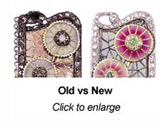 Reproductions of jewelry from other periods are also in great
demand. Many are skillfully made, using quality materials, and are sold as
reproductions done in the style of a particular period. It is important that
reproductions be so identified and not passed off as period jewelry.
Reproductions of jewelry from other periods are also in great
demand. Many are skillfully made, using quality materials, and are sold as
reproductions done in the style of a particular period. It is important that
reproductions be so identified and not passed off as period jewelry.
Authentication & Valuation
 Authenticating antique and period jewelry takes special skill and experience.
The jeweler must determine whether a piece is from an earlier period or has
simply been made to look old.
Authenticating antique and period jewelry takes special skill and experience.
The jeweler must determine whether a piece is from an earlier period or has
simply been made to look old.
The appraising jeweler must know what to expect from each historical period—what metals and alloys were available or commonly used, what shapes were popular for stones and how the stone-cutting was done. Every period has its personality, and the jeweler must be familiar with subtle details and nuances of style. He must know the importance of a particular provenance and be able to distinguish an authentic signature from a fake one.
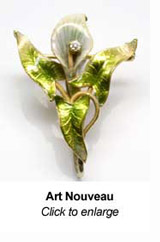 “It’s a minefield out there,” said one expert. “More
and more jewelers are getting better and better at knocking off the old pieces
in very subtle ways…. They’ve learned to cut the stones so they
look asymmetrical and old and beat up. They’ve learned to work the metals
so they have a patina and age to them.”
“It’s a minefield out there,” said one expert. “More
and more jewelers are getting better and better at knocking off the old pieces
in very subtle ways…. They’ve learned to cut the stones so they
look asymmetrical and old and beat up. They’ve learned to work the metals
so they have a patina and age to them.”
Buyers — jewelers as well as individual purchasers — must always be wary. One jeweler pointed out that auction catalogs from 50 years ago would say a piece of jewelery was “by Tiffany” or “by Cartier.” Now the catalogs say “signed Tiffany” or “signed Cartier,” indicating that a signature is present but the auction house isn’t necessarily saying the piece is genuine.
Copies and imitations of period jewelry are being made in centers all over the world. Some are of high quality and workmanship, advertised and sold as reproductions. However, after a year or two on the market, such pieces may no longer be identified as reproductions but be passed off as genuine period jewelry.
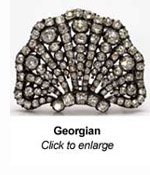 The number of out-and-out fakes is at an all-time high. Technological advances
allow treating stones and imitating metal patinas as never before. Scammers
even use auction catalogs to find models of jewelry to copy.
The number of out-and-out fakes is at an all-time high. Technological advances
allow treating stones and imitating metal patinas as never before. Scammers
even use auction catalogs to find models of jewelry to copy.
Further muddying the waters are altered pieces and the so-called “put-together” pieces. An old brooch may have some new stones. A long necklace may have been shortened for a more fashionable look. Even replacement of a clasp can ruin the authenticity of a fine piece and lower its value.
Elise B. Misiorowski, museum director of the Gemological Institute of America, says that dealing with antique and period jewelry requires “forensic jewelry history. You have to be proficient with a loupe and you have to know what you’re looking at.”
Is Older More Valuable?
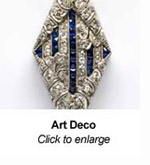 Many people assume that old jewelry is by definition valuable. This is not
necessarily the case. A piece may have no redeeming qualities except that
it has lasted for 150 years.
Many people assume that old jewelry is by definition valuable. This is not
necessarily the case. A piece may have no redeeming qualities except that
it has lasted for 150 years.
The value of a piece of jewelry depends upon the intrinsic value of the materials, the quality of the craftsmanship, and the market’s demand. In jewelry, as of other things, styles go in and out of fashion. Even a good quality piece can lose value if its style is no longer considered appealing — that is, if the jewelry is not salable.
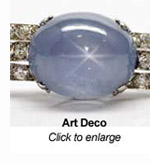 Accurate valuation of period jewelry can be made only by a jeweler/ appraiser
who regularly handles such jewelry, who knows the market for such pieces,
and who can recognize alterations, reproductions and fakes.
Accurate valuation of period jewelry can be made only by a jeweler/ appraiser
who regularly handles such jewelry, who knows the market for such pieces,
and who can recognize alterations, reproductions and fakes.
Even experts often depend on independent grading from major labs when purchasing estate jewelry. Ralph Esmerian, considered a gem dealer’s gem dealer, recommends American Gemological Laboratories for colored gemstones and the Gemological Institute of America for diamonds.
FOR AGENTS & UNDERWRITERS
Beware of important-sounding words on an appraisal that say nothing about quality. “Antique” only means the piece is at least 100 years old. Do not take it to mean unique or valuable.
Terms like “Victorian,” “Edwardian,” “Art Deco,” etc., describe the style of a period. They say nothing about value.
A contemporary piece in the style of an earlier period should be so described, so it is not confused with jewelry made during that period.
For all jewelry, old or contemporary, encourage the policyholder to submit the insurance industry’s standard Jewelry Appraisal (ACORD 78/79), written by a Certified Insurance Appraiser™.
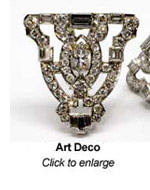 Autheticating and valuing antique and period jewelry requires skill and experience.
Be sure the appraiser is a jeweler who regularly deals in such jewelry, one
who is familiar with the pricing in this specialized market and alert to its
scams.
Autheticating and valuing antique and period jewelry requires skill and experience.
Be sure the appraiser is a jeweler who regularly deals in such jewelry, one
who is familiar with the pricing in this specialized market and alert to its
scams.
Be sure the appraisal includes a picture of the jewelry. This can be invaluable in the event of a loss. A sales receipt is also very useful.
If the jewelry is insured under a valued contract, consider having independent verification of the age or period of the piece and its valuation.
FOR ADJUSTERS
Scrutinize the appraisal. Investigate the appraiser’s qualifications. Remember that appraising period jewelry requires an expertise beyond that of most jewelers dealing in contemporary pieces.
Compare the appraisal’s valuation with the sales receipt. If the jewelry is an heirloom, request additional documentation. Don’t take a statement about inheritance at face value. Just because jewelry is old, that doesn’t mean there is no paper trail.
Look at the photo. Refer to auction catalogs or public auction sites for similar jewelry to verify the valuation.
Consider using a jewelry insurance expert’s help in settling the claim,
to avoid overpayments on antique and period jewelry of high value.
©2000-2025, JCRS Inland Marine Solutions, Inc. All Rights Reserved. www.jcrs.com

